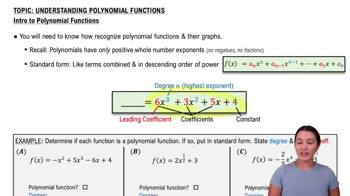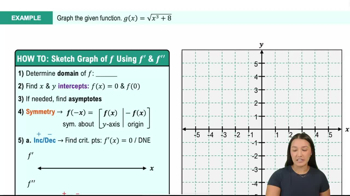Table of contents
- 0. Functions7h 52m
- Introduction to Functions16m
- Piecewise Functions10m
- Properties of Functions9m
- Common Functions1h 8m
- Transformations5m
- Combining Functions27m
- Exponent rules32m
- Exponential Functions28m
- Logarithmic Functions24m
- Properties of Logarithms34m
- Exponential & Logarithmic Equations35m
- Introduction to Trigonometric Functions38m
- Graphs of Trigonometric Functions44m
- Trigonometric Identities47m
- Inverse Trigonometric Functions48m
- 1. Limits and Continuity2h 2m
- 2. Intro to Derivatives1h 33m
- 3. Techniques of Differentiation3h 18m
- 4. Applications of Derivatives2h 38m
- 5. Graphical Applications of Derivatives6h 2m
- 6. Derivatives of Inverse, Exponential, & Logarithmic Functions2h 37m
- 7. Antiderivatives & Indefinite Integrals1h 26m
- 8. Definite Integrals4h 44m
- 9. Graphical Applications of Integrals2h 27m
- 10. Physics Applications of Integrals 2h 22m
5. Graphical Applications of Derivatives
Curve Sketching
Problem 4.4.23
Textbook Question
Graphing functions Use the guidelines of this section to make a complete graph of f.
f(x) = x³ - 6x² - 135x
 Verified step by step guidance
Verified step by step guidance1
Step 1: Identify the domain of the function f(x) = x³ - 6x² - 135x. Since this is a polynomial function, the domain is all real numbers.
Step 2: Find the critical points by taking the derivative of f(x) to find f'(x). The derivative is f'(x) = 3x² - 12x - 135. Set f'(x) = 0 to find the critical points.
Step 3: Solve the equation 3x² - 12x - 135 = 0 to find the values of x where the function has critical points. Use the quadratic formula or factorization to find these values.
Step 4: Determine the behavior of the function at the critical points by using the second derivative test. Find f''(x) = 6x - 12 and evaluate it at the critical points to determine concavity.
Step 5: Analyze the end behavior of the function by considering the leading term x³. As x approaches positive or negative infinity, the function will behave like x³, which means it will go to positive infinity as x goes to positive infinity and negative infinity as x goes to negative infinity.
 Verified video answer for a similar problem:
Verified video answer for a similar problem:This video solution was recommended by our tutors as helpful for the problem above
Video duration:
10mPlay a video:
Was this helpful?
Key Concepts
Here are the essential concepts you must grasp in order to answer the question correctly.
Polynomial Functions
A polynomial function is a mathematical expression involving a sum of powers in one or more variables multiplied by coefficients. In this case, f(x) = x³ - 6x² - 135x is a cubic polynomial, which means its highest degree is three. Understanding the general shape and behavior of polynomial functions is crucial for graphing them effectively.
Recommended video:

Introduction to Polynomial Functions
Critical Points and Extrema
Critical points occur where the derivative of a function is zero or undefined, indicating potential local maxima, minima, or points of inflection. To find these points for f(x), we need to compute its derivative, set it to zero, and solve for x. Analyzing these points helps in determining the overall shape and turning points of the graph.
Recommended video:

Critical Points
End Behavior
End behavior describes how a function behaves as the input values approach positive or negative infinity. For polynomial functions, the leading term dictates this behavior. In the case of f(x), since the leading term is x³, the graph will rise to positive infinity as x approaches positive infinity and fall to negative infinity as x approaches negative infinity, shaping the overall graph.
Recommended video:

Cases Where Limits Do Not Exist

 11:41m
11:41mWatch next
Master Summary of Curve Sketching with a bite sized video explanation from Callie
Start learning




